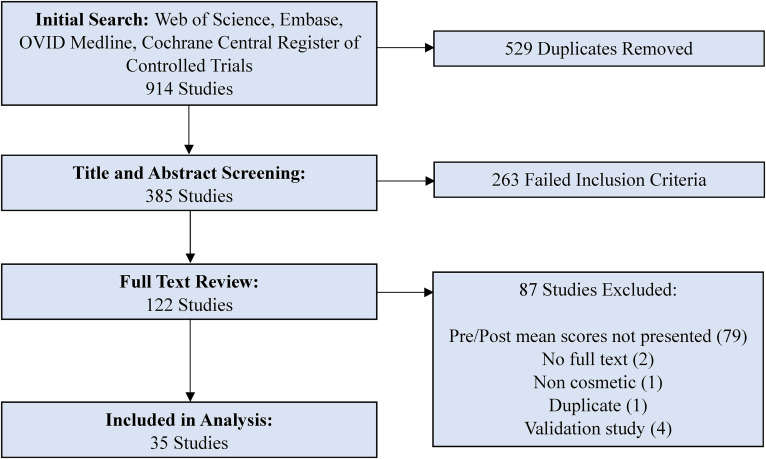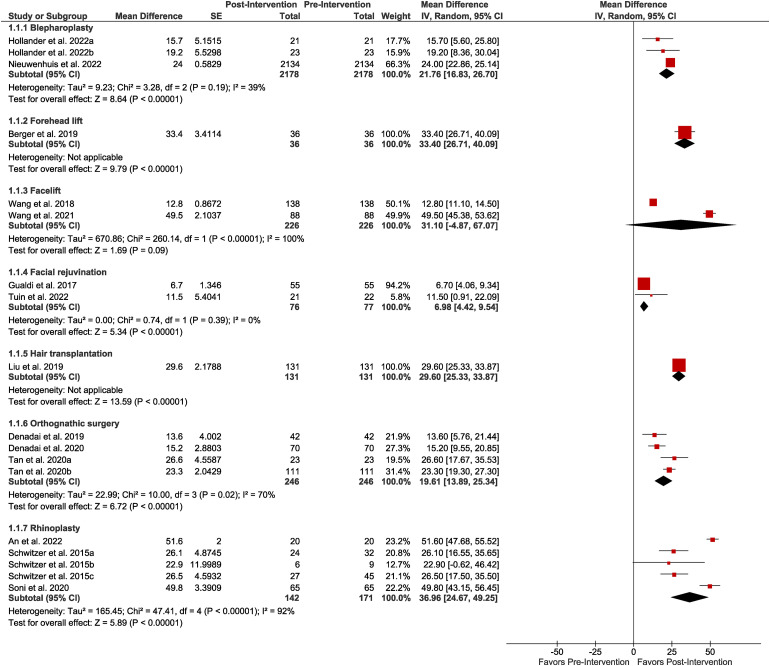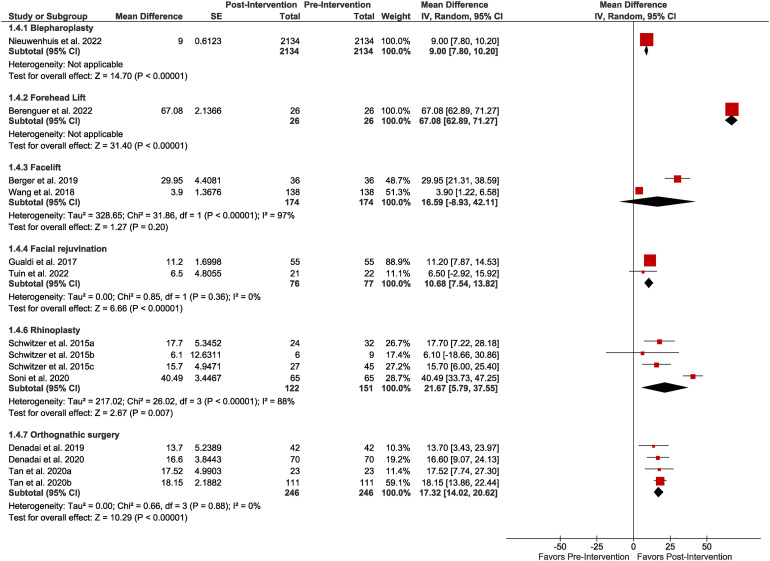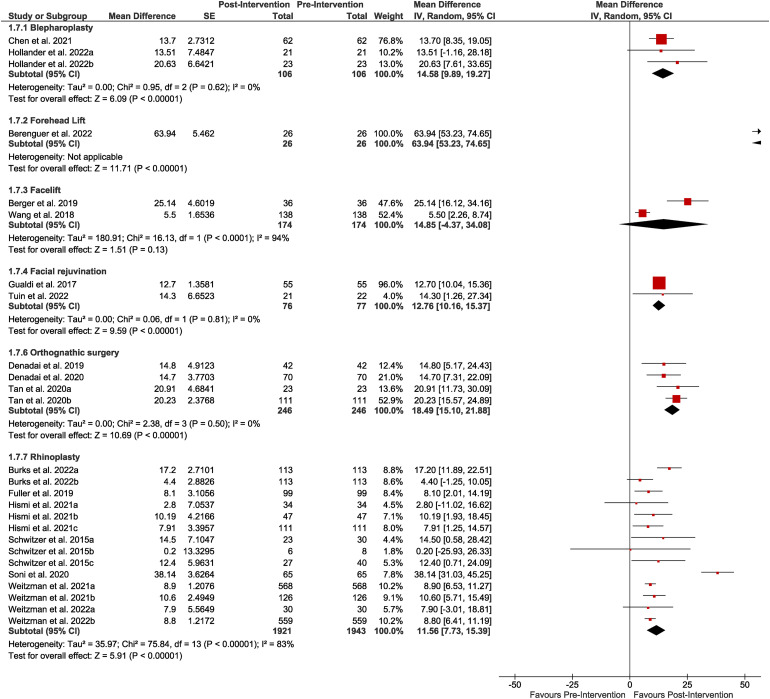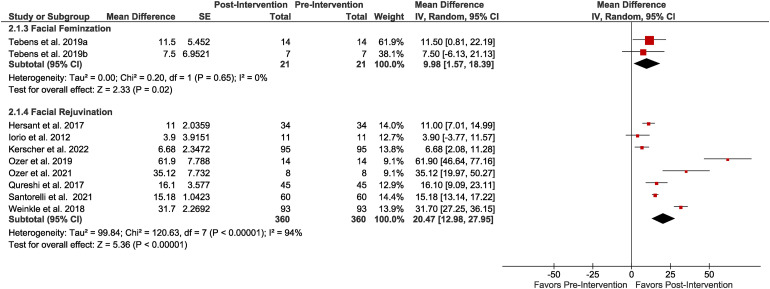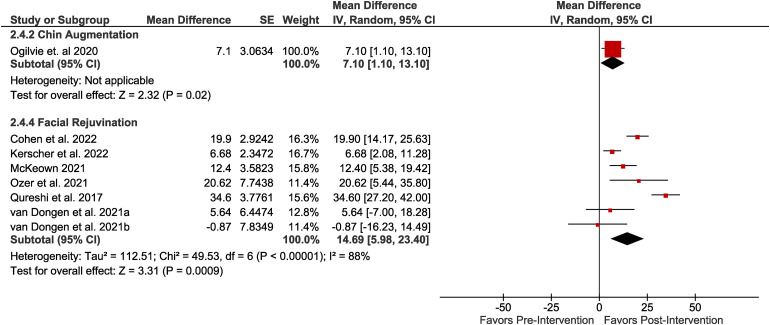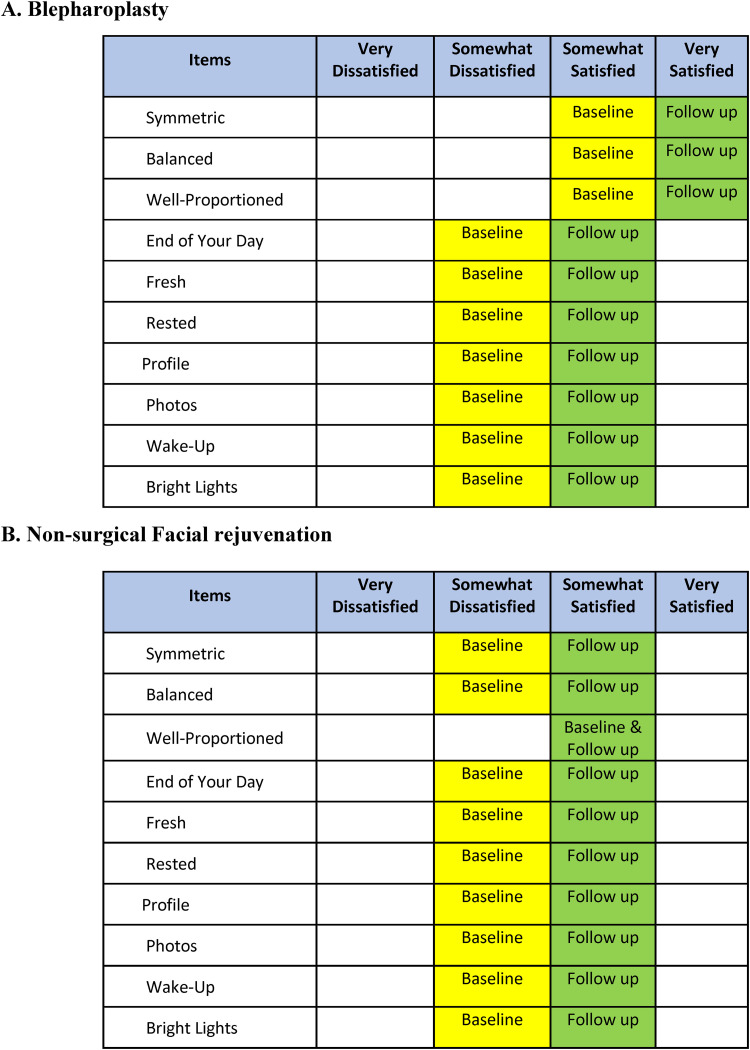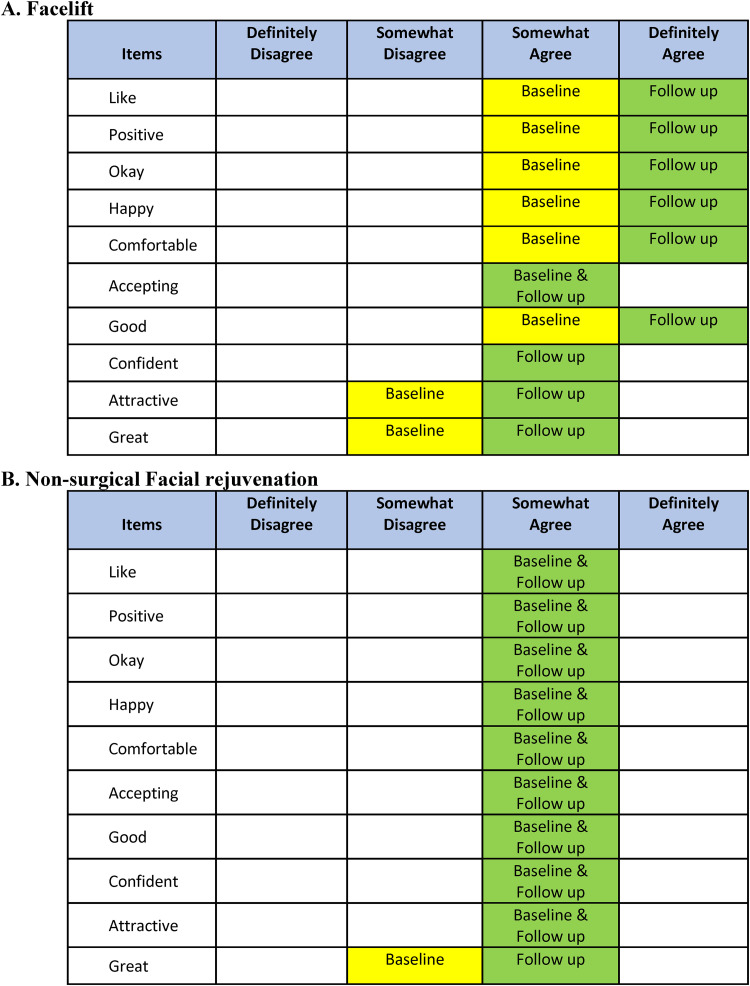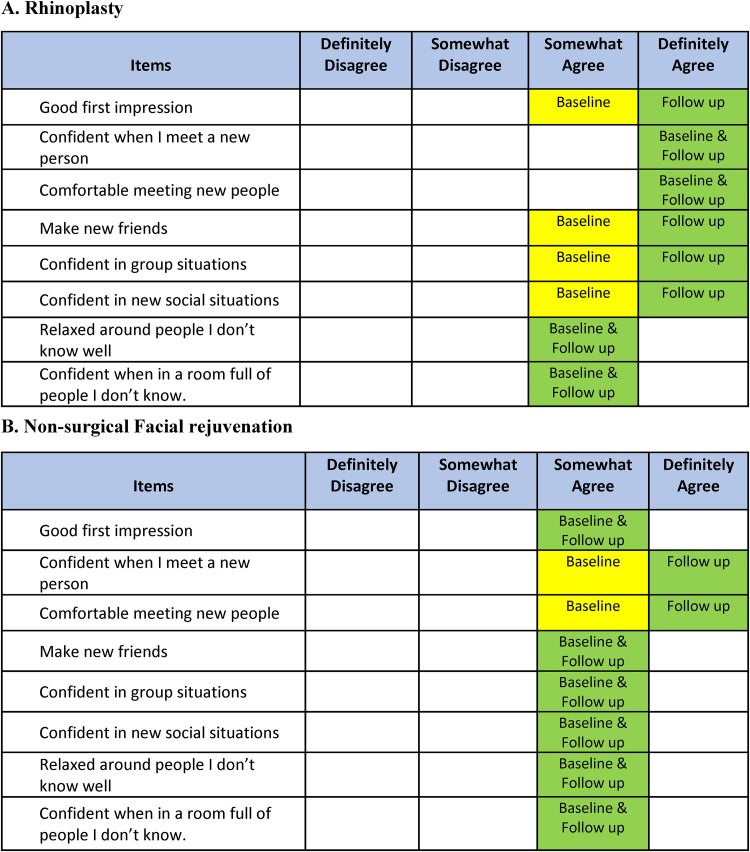Abstract
Background: The FACE-Q Aesthetic module measures patient-important outcomes following surgical and non-surgical facial cosmetic procedures. Objective: The primary aim of this systematic review was to summarize the pre- to post-intervention mean differences of facial aesthetic interventions that evaluate outcomes using the FACE-Q Face Overall, Psychological, and Social scales. Methods: Ovid Medline, Embase, Cochrane, and Web of Science databases were searched on December 20, 2022 with the assistance of a health-research librarian (CRD42023404238). Studies that examined any surgical or non-surgical facial aesthetic intervention in adult patients and used FACE-Q Aesthetics Face Overall, Psychological, and/or Social scales to measure participants before and after treatment were included for analysis. Results: Of 914 potential articles screened, 35 studies met the inclusion criteria. Most studies evaluated surgical (n = 22, 62.9%) versus non-surgical facial cosmetic interventions (n = 13, 37.1%). Rhinoplasty [37.0 points, 95% CI 24.7-49.3, P < 0.01] demonstrated the largest weighted increase in Face Overall scores, whereas the largest increase in Psychological [67.1 points, 95% CI 62.9–71.3, P < 0.01] and Social [63.9 points, 95% CI 53.2–74.6, P < 0.01] scores was demonstrated by a single study evaluating surgical forehead lifts, respectively. Conclusions: This meta-analysis leverages FACE-Q Aesthetic module scoring to present the expected mean differences in Face Overall, Psychological, and Social scale scores for various surgical and non-surgical facial cosmetic interventions. The findings from this review may be used to indirectly compare interventions and contribute to sample size calculations when planning future studies.
Keywords: Aesthetics, FACE-Q, systematic review, meta-analysis
Résumé
Historique: Le module esthétique FACE-Q mesure les résultats importants pour le patient après des interventions esthétiques chirurgicales et non chirurgicales du visage. Objectif: L’objectif primaire de la présente analyse systématique consistait à résumer les différences moyennes d’interventions esthétiques du visage avant et après l’opération, dont les résultats étaient évalués à l’aide des échelles globales, psychologiques et sociales de l’esthétique faciale FACE-Q. méthodologie: Le 20 décembre 2022, les chercheurs ont fouillé les bases de données Ovid Medline, Embase, Cochrane et Web of Science avec l’aide d’un bibliothécaire spécialisé en recherche en santé (CRD42023404238). Les études qui portaient sur toute intervention esthétique chirurgicale ou non chirurgicale du visage chez des patients adultes et qui faisaient appel aux échelles globales, psychologiques ou sociales de l’esthétique faciale FACE-Q pour mesurer les participants avant et après leur traitement ont été incluses dans l’analyse. Résultats: Sur les 914 articles potentiels extraits, 35 études respectaient les critères d’inclusion. La plupart évaluaient les interventions esthétiques chirurgicales (n = 22, 62,9%) du visage par rapport aux interventions non chirurgicales (n = 13, 37,1%). La rhinoplastie [37,0 points, IC à 95%, 24,7 à 49,3, P < 0,01] a obtenu la plus forte progression pondérée des scores globaux totaux, tandis que la plus forte progression des scores psychologiques [67,1 points, IC à 95%, 62,9 à 71,3, P < 0,01] et sociaux [63,9 points, IC à 95%, 53,2 à 74,6, P < 0,01] a été établie par une seule étude évaluant les redrapages du front. Conclusion: La présente méta-analyse a tiré parti des scores du module esthétique FACE-Q pour présenter les différences moyennes anticipées des scores des échelles globales, psychologiques et sociales de diverses interventions esthétiques chirurgicales et non chirurgicales du visage. Les observations tirées de la présente analyse pourraient être utilisées pour procéder à une comparaison indirecte des interventions et contribuer aux calculs des tailles d’échantillons lors de la planification de prochaines études.
Mots-clés: esthétique, FACE-Q, analyse systématique, méta-analyse
Introduction
The FACE-Q Aesthetic module is a validated patient-reported outcome measure that converts subjective patient experiences into interpretable, quantitative data. Since becoming available to the research community in 2010, the FACE-Q Aesthetic module has been used extensively to assess outcomes for both surgical and non-surgical aesthetic interventions, including facelifts, rhinoplasty, and minimally invasive procedures.1–4 The FACE-Q Aesthetic module consists of 34 independently functioning scales and six checklists which evaluate the patient's perspective on satisfaction with facial appearance, health-related quality of life (HRQL), and adverse effects of treatment.1,5 As the FACE-Q is not intervention specific, it can be used to measure and compare outcomes following a variety of facial aesthetic procedures.
While secondary analyses have attempted to summarize the effect of various facial cosmetic interventions using the FACE-Q, these studies have been limited to narrative and non-systematic reviews of the existing literature.3,4 Ottenhof et al 3 identified 70 primary studies of facial aesthetic interventions using any FACE-Q aesthetic module scale(s); however, the authors did not summarize the results of these studies within their analysis. Similarly, Hoffman and Fabi 4 identified 31 minimally invasive facial aesthetic procedures using the FACE-Q; however, this narrative analysis was limited only to minimally invasive interventions.
As the FACE-Q was recently US Food and Drug Administration (FDA)-approved as a medical device development tool (MDDT), there is a need to summarize the existing evidence in the form of a systematic review and meta-analysis. Such a review could be referenced by future investigators when performing sample size calculations and when selecting appropriate time horizons for a study design.6,7 Specifically, when performing sample size calculations comparing interventions using the FACE-Q Aesthetic module scales using an independent t-test, an estimate of the predicted effect size (eg, the predicted difference in the mean scores between study groups) as well as the variability of the sample (ie, standard deviation (SD)) is required.8–10 Typically, such values are obtained from previous studies reported within the literature or from expert consultation. To facilitate these predictions, the authors attempt to summarize the existing primary evidence to provide weighted mean differences of various surgical and non-surgical facial aesthetic interventions using commonly reported FACE-Q Aesthetic module scales. 6
The primary aim of this systematic review was to identify the pre- to post-intervention differences in mean scores for three FACE-Q scales – Face Overall, Psychological Well-being, and Social Function scales – for both surgical and non-surgical facial cosmetic interventions.
Methods
This study was reported according to the Preferred Reporting Items for Systematic Reviews and Meta-Analysis (PRISMA) guidelines. 11 The protocol was registered a priori on PROSPERO (CRD42023404238).
Types of Studies
This review included English language, randomized, quasi-randomized, single cohort, and comparative observational studies that measured mean pre-treatment and post-intervention surgical and non-surgical facial cosmetic outcomes using the FACE-Q Face Overall, Psychological, or Social scales.
Search Strategy
Ovid Medline, Embase, Cochrane Central Register of Controlled Trials, and Web of Science were searched on December 20, 2022 with the assistance of a health sciences librarian (Supplementary Appendix 1).
Studies were included for analysis if they: (1) examined any surgical or non-surgical facial aesthetic intervention in adult patients (≥ 18 years old); (2) used the FACE-Q Aesthetics module Face Overall, Psychological, and/or Social scale(s) to measure participant scores (with appropriate SDs) pre-intervention and at any time horizon following the intervention; and (3) were a primary observational or experimental study design. Studies were excluded if they: (1) were used in the validation of any FACE-Q Aesthetics Module scale; (2) were case studies, review articles, commentary, or conference abstracts; and (3) were non-English language.
Titles and abstracts, as well as full texts, were screened independently and in duplicate by two reviewers using piloted screening forms. Conflicts were resolved via consensus.
Outcomes
Facial appearance and HRQL outcomes were evaluated in this study using the FACE-Q Aesthetic module scales. Outcome measures selected included the pre-intervention and post-intervention mean difference in the Face Overall, Psychological, and/or Social scale(s). These scales were selected as they were the most frequently used scales as detailed in a companion paper that described best practices for FACE-Q Aesthetics research. 6 Any duration of follow-up reported as the study's primary time horizon was extracted; if not specified, data from the final time horizon was used. Outcomes were analysed according to whether the primary intervention was deemed to be surgical or non-surgical.
Notably, the Face Overall scale consists of 10-items that together measure satisfaction with the appearance of the entire face. The Psychological scale contains 10-items and evaluates an individual's psychological function with their facial appearance in mind. Finally, the 8-item Social scale measures social function in the context of facial appearance. The FACE-Q Aesthetic module scales are converted from an ordinal score into a continuous scale, from 0 to 100, where higher scores (ie, a positive pre-intervention and post-intervention mean difference) correspond to improved appearance and HRQL outcomes.
Data Extraction
Data extraction was conducted, independently and in duplicate by two reviewers using a piloted data extraction form created on Microsoft Excel (Microsoft Corp., Redmond, Wash.). Disagreements were resolved by consensus and discussion with a third reviewer. For primary comparative studies that included two or more intervention groups, pre-intervention and post-intervention FACE-Q data were extracted for each group separately. The following characteristics were extracted: first author, journal, procedure details, time horizon for FACE-Q outcome, and the FACE-Q aesthetic scale pre-intervention and post-intervention mean scores and SD.
Risk of Bias
Risk of bias assessments were performed in duplicate using the ‘Methodological quality and synthesis of case series and case reports’ framework.9,12 Conflicts were resolved via consensus. Assessments are summarized in Table 1.
Table 1.
Characteristics of Included Primary Studies.
| Author | Year | Design | Journal | Domain | Facial aesthetic procedure | Procedure details | Risk of bias | FACE-Q Aesthetic Scales | Time horizon | ||
|---|---|---|---|---|---|---|---|---|---|---|---|
| Face overall | Psychological | Social | |||||||||
| An et al 13 | 2022 | Observational | Aesthetic Plast Surg. | Surgical | Rhinoplasty | Rhinoplasty with full-face fat transfer | High | ✓ | NR | ||
| Berenguer et al 14 | 2022 | Observational | J Plast Reconstr Aesthet Surg. | Surgical | Forehead lift | Primary isolated aesthetic forehead reduction | Low | ✓ | ✓ | NR | |
| Berger et al 15 | 2019 | Observational | Aesthetic Plast Surg. | Surgical | Facelift | SMAS Rhytidectomy | Some concerns | ✓ | ✓ | ✓ | 12 months |
| Burks et al 16 | 2022 | Observational | Laryngoscope | Surgical | Rhinoplasty | Group A: Septorhinoplasty with spreader graft placement and component dorsal hump reduction Group B: Septorhinoplasty with spreader graft placement |
Some concerns | ✓ | NR | ||
| Chen et al 17 | 2021 | Observational | Aesthet Surg J. | Surgical | Blepharoplasty | Transconjunctival lower blepharoplasty | High | ✓ | 11 months | ||
| Denadai et al 18 | 2019 | Observational | J Clin Med. | Surgical | Orthognathic surgery | Orthognathic surgery | Low | ✓ | ✓ | ✓ | 12 months |
| Denadai et al 19 | 2020 | Observational | Plast Reconstr Surg. | Surgical | Orthognathic surgery | Orthognathic surgery | Some concerns | ✓ | ✓ | ✓ | NR |
| Domela Nieuwenhuis et al 20 | 2022 | Observational | Aesthet Surg J. | Surgical | Upper blepharoplasty | Upper blepharoplasty | Some concerns | ✓ | ✓ | 12 months | |
| Fuller et al 21 | 2019 | Observational | JAMA Facial Plast Surg. | Surgical | Rhinoplasty | Septorhinoplasty with spreader graft placement | High | ✓ | 6 months | ||
| Gualdi et al 22 | 2017 | Observational | Aesthetic Plast Surg. | Surgical | Facial rejuvenation | Minimal undermining suspension technique | High | ✓ | ✓ | ✓ | 12 months |
| Hismi et al 23 | 2021 | Observational | Facial Plast Surg Aesthet Med | Surgical | Rhinoplasty | Group A: Septorhinoplasty with spreader graft and alar rim graft Group B: Septorhinoplasty with spreader graft and lateral crural strut graft Group C: Septorhinoplasty with spreader graft |
High | ✓ | NR | ||
| Hollander et al 24 | 2022 | RCT | Int J Oral Maxillofac Surg | Surgical | Upper blepharoplasty | Group A: Upper blepharoplasty with orbicularis oculi muscle excision Group B: Upper blepharoplasty |
Low | ✓ | ✓ | 12 months | |
| Liu et al 25 | 2019 | Observational | Aesthetic Plast Surg. | Surgical | Hair transplant | Follicle unit extraction | Some concerns | ✓ | 6 months | ||
| Schwitzer et al 26 | 2015 | Observational | Aesthet Surg J. | Surgical | Rhinoplasty | Group A: Women Group B: Men |
Some concerns | ✓ | ✓ | ✓ | 7 months |
| Schwitzer et al 27 | 2015 | Observational | Plast Reconstr Surg. | Surgical | Rhinoplasty | Rhinoplasty | Some concerns | ✓ | ✓ | ✓ | 5 months |
| Soni et al 28 | 2020 | Observational | J Laryngol Otol. | Surgical | Rhinoplasty | Rhinoplasty | High | ✓ | ✓ | ✓ | 6 months |
| Tan et al 29 | 2020 | Observational | J Craniomaxillofac Surg. | Surgical | Orthognathic surgery | Group A: Orthognathic surgery for dento-skeletal class II patients Group B: Orthognathic surgery for dento-skeletal class III patients |
Some concerns | ✓ | ✓ | ✓ | 16 months |
| Tuin et al 30 | 2022 | Observational | Plast Reconstr Surg. | Surgical | Facial rejuvenation | Facial fat grafting | Low | ✓ | ✓ | ✓ | 12 months |
| Wang et al 31 | 2018 | Observational | Ann Plast Surg. | Surgical | Facelift | Subcutaneous face and neck lift | Some concerns | ✓ | ✓ | ✓ | 12 months |
| Wang et al 32 | 2021 | Observational | Aesthet Surg J. | Surgical | Facelift | Periauricular purse-string reinforced with SMAS plication and malar fat pad elevation | Some concerns | ✓ | 11 months | ||
| Weitzman et al 33 | 2021 | Observational | Laryngoscope | Surgical | Rhinoplasty | Group A: Septorhinoplasty with extended spreader graft Group B: Septorhinoplasty with standard spreader graft |
High | ✓ | NR | ||
| Weitzman et al 34 | 2022 | Observational | Laryngoscope | Surgical | Rhinoplasty | Group A: Septorhinoplasty with spreader graft with upper lateral cartilage release Group B: Septorhinoplasty with spreader graft |
High | ✓ | NR | ||
| Cohen et al 35 | 2022 | Observational | Aesthet Surg J. | Non-surgical | Facial rejuvenation | OnabotulinumtoxinA for dynamic rhytids, hyaluronic acid filler for volume restoration and/or for lines and folds, bimatoprost ophthalmic solution 0.03% for eyelash hypotrichosis | High | ✓ | ✓ | 4 months | |
| Hersant et al 36 | 2017 | Observational | Lasers Surg Med. | Non-surgical | Facial rejuvenation | Er:YAG + SMA lazer | High | ✓ | 6 months | ||
| Iorio et al 37 | 2012 | Observational | Aesthetic Plast Surg. | Non-surgical | Facial rejuvenation | OnabotulinumtoxinA and hyaluronic acid filler | High | ✓ | 1 week | ||
| Kerscher et al 38 | 2022 | Observational | Clin Cosmet Investig Dermatol. | Non-surgical | Facial rejuvenation | Cell-free blood secretome | High | ✓ | ✓ | ✓ | 48 weeks |
| McKeown et al 39 | 2021 | Observational | Plast Reconstr Surg Glob Open. | Non-surgical | Facial rejuvenation | Hyaluronic acid filler and/or with onabotulinumtoxinA | High | ✓ | ✓ | 2 weeks | |
| Ogilvie et al 40 | 2020 | RCT | Aesthet Surg J. | Non-surgical | Chin augmentation | Hyaluronic acid filler | High | ✓ | 18 months | ||
| Ozer et al 41 | 2019 | Observational | J Craniofac Surg. | Non-surgical | Facial rejuvenation | Micro-autologous fat transplantation with platelet-rich plasma injection | High | ✓ | 9 months | ||
| Ozer et al 42 | 2021 | Observational | Aesthetic Plast Surg. | Non-surgical | Facial rejuvenation | Autologous biologic vitamin-C-added filler | High | ✓ | ✓ | ✓ | 4 months |
| Qureshi et al 43 | 2017 | Observational | Aesthetic Plast Surg. | Non-surgical | Facial rejuvenation | onabotulinumtoxinA/incobotulinumtoxinA and/or soft-tissue filler | High | ✓ | ✓ | ✓ | 1 month |
| Santorelli et al 44 | 2021 | Observational | J Cosmet Dermatol. | Non-surgical | Facial rejuvenation | Thread suspension technique | High | ✓ | 6 months | ||
| Tebbens et al 45 | 2019 | Observational | J Sex Med. | Non-surgical | Facial feminization/ masculinization |
Group A: Transwomen Group B: Transmen |
Low | ✓ | 12 months | ||
| Van Dongen et al 46 | 2021 | RCT | Aesthet Surg J. | Non-surgical | Facial rejuvenation | Group A: Lipofilling + platelet-rich plasma + tissue stromal vascular fraction Group B: Lipofilling + platelet-rich plasma |
High | ✓ | ✓ | 12 months | |
| Weinkle et al 47 | 2018 | Observational | Aesthet Surg J. | Non-surgical | Facial rejuvenation | OnabotulinumtoxinA for dynamic rhytids, hyaluronic acid filler for volume restoration and/or for lines and folds, bimatoprost ophthalmic solution 0.03% for eyelash hypotrichosis | High | ✓ | 4 months | ||
RCT, Randomized control trial; NR, Not reported.
Data Analysis
The analysis was performed using the general inverse variance method and random-effects models. Continuous outcomes were summarized as mean differences with 95% confidence intervals using Review Manager 5 [Review Manager (RevMan) Version 5.3. Copenhagen: The Nordic Cochrane Centre, The Cochrane Collaboration, 2014]. Individual study mean differences were summarized using a pooled, weighted mean difference for each surgical and non-surgical procedure. The test for overall effect for each weighted mean difference and corresponding P-value was calculated using a Z-test. All included studies utilized individual participants as the unit of analysis.
Heterogeneity of pooled results was evaluated using a combination of visual inspection (magnitude of point estimates and overlapping CI of the forest plot) and statistical analyses (Chi2 test with significance set at P ≤ 0.10 and I2 statistic). The magnitude of heterogeneity was defined by the I2 value and categorizes as follows: 0–40% represented ‘might not be important’, 30–60% represented ‘moderate’ heterogeneity, 50–90% represented ‘substantial’ heterogeneity, and 75–100% represented ‘considerable’ heterogeneity. Statistical significance was determined to be P ≤ 0.05. 48
Results
There were 914 titles and abstracts screened for study inclusion; n = 35 studies were included following the full-text review.13–47 The PRISMA flow diagram is demonstrated in Figure 1.
Figure 1.
PRISMA flow diagram of included studies.
Surgical Interventions
Most included studies evaluated surgical facial cosmetic interventions (n = 22, 62.9%) including: blepharoplasty, facelift, forehead lift, facial rejuvenation, hair transplantation, orthognathic surgery, and rhinoplasty (Table 1).
Face Overall Scale
Fifteen studies evaluated outcomes using the FACE-Q Face Overall scale, for the following procedures: blepharoplasty, facelift, forehead lift, surgical facial rejuvenation (ie, fat grafting), hair transplantation, orthognathic surgery, and rhinoplasty. The pre- and post-intervention mean differences are presented in Figure 2. Two studies (3 cohorts, 2178 participants) evaluated blepharoplasty, corresponding to weighted mean difference of 21.8 points [95% CI 16.8 to 26.7, P < 0.01]. This pooled estimate demonstrated low heterogeneity (I2 = 39%) with included studies having ‘low’ to ‘moderate’ risk of bias. Three studies (3 cohorts, 262 participants) evaluated facelifts, with ‘considerable’ heterogeneity (I2 = 99%) and ‘moderate’ risk of bias. These studies demonstrated a weighted mean difference of 31.9 points [95% CI 5.8 to 57.9, P = 0.02]. Two studies (2 cohorts, 76 participants) with ‘low’ and ‘high’ risk of bias evaluated various facial rejuvenation procedures – including facial fat grafting and minimal undermining suspension techniques. The weighted mean difference associated with these studies was 7.0 points [95% CI 4.4 to 9.54, P < 0.01] with low heterogeneity (I2 = 0%). One study (1 cohort, 131 participants) that evaluated hair transplantation demonstrated a weighted mean difference of 29.6 points [95% CI 25.3 to 33.8 points, P < 0.01] and was determined to have ‘moderate’ risk of bias. Three included primary studies (4 cohorts, 246 participants) evaluated the impact of orthognathic surgery. These studies demonstrated ‘low’ to ‘moderate’ risk of bias with a weighted mean difference of 19.6 points [95% CI 13.9 to 25.3, P < 0.01] and ‘substantial’ (I2 = 70%) heterogeneity. Finally, three studies (5 cohorts, 142 participants) evaluated rhinoplasty outcomes and demonstrated a weighted mean difference of 37.0 points [95% CI 24.7 to 49.3, P < 0.01] with ‘considerable’ heterogeneity (I2 = 92%).
Figure 2.
Forest plot for surgical interventions with FACE-Q Face Overall scale outcomes.
Psychological Scale
Twelve studies evaluated outcomes using the FACE-Q Psychological scale. These pre- and post-intervention mean differences are presented in Figure 3. A single included primary study (1 cohort, 2134 participants) with ‘moderate’ risk of bias that evaluated blepharoplasty outcomes demonstrated a weighted post-operative mean difference of 9 points [95% CI 7.8 to 10.2, P < 0.01]. Another single study that evaluated forehead lifts (1 cohort, 26 participants) with ‘low’ risk of bias demonstrated a mean difference of 67.1 points [95% CI 62.9 to 71.3, P < 0.01]. Two studies (2 cohorts, 174 participants) evaluated facelifts and demonstrated a 16.6 point difference [95% CI −8.9 to 42.1, P = 0.2] with ‘considerable’ heterogeneity (I2 = 97%) and ‘moderate’ risk of bias. Surgical facial rejuvenation procedures (2 cohorts, 76 participants) with ‘low’ and ‘high’ risk of bias showed a weighted mean difference of 10.7 points [95% CI 7.5 to 13.8, P < 0.01] with heterogeneity that ‘might not be important’ (I2 = 0). Two studies evaluated rhinoplasty (4 cohorts, 122 participants) and reported a post-operative weighted mean difference of 21.7 points [95% CI 5.79 to 37.6, P = 0.01] with ‘considerable’ heterogeneity (I2 = 88%) as well as ‘high’ and ‘moderate’ risk of bias. Finally, orthognathic surgery outcomes were evaluated in three studies (4 cohorts, 246 participants) and demonstrated a weighted mean difference of 17.3 points [95% CI 14.0 to 20.6, P < 0.01] with low heterogeneity (I2 = 0) and ‘moderate’ risk of bias.
Figure 3.
Forest plot for surgical interventions with FACE-Q Psychological scale outcomes.
Social Scale
Eighteen surgical studies evaluated outcomes using the FACE-Q Social scale (Figure 4). Two studies (3 cohorts, 106 participants) evaluated blepharoplasty outcomes and demonstrated a weighted mean difference of 14.6 points [95% CI 9.9 to 19.3, P < 0.01] with ‘low’ heterogeneity (I2 = 0) as well as ‘high’ and ‘low’ risk of bias. One study (1 cohort, 26 participants) with ‘low’ risk of bias that evaluated outcomes following forehead lift procedures reported a post-operative mean difference of 63.9 points [95% CI 53.2 to 74.6, P < 0.01]. Two studies (2 cohorts, 174 participants) evaluated facelift procedures and demonstrated a 14.9 point mean difference [95% CI −4.4 to 34.1, P = 0.13] with ‘considerable’ heterogeneity (I2 = 94%) and ‘moderate’ risk of bias. Surgical facial rejuvenation procedures were assessed by two studies (2 cohorts, 76 participants) with ‘low’ and ‘high’ risk of bias. These studies demonstrated a pooled mean difference of 12.8 points [95% CI 10.2 to 15.4, P < 0.01] with ‘low’ heterogeneity (I2 = 0). Orthognathic surgery was evaluated by three studies (4 cohorts, 246 participants) which demonstrated a weighted mean difference of 18.5 points [95% CI 15.1 to 21.9, P < 0.01] with ‘low’ heterogeneity (I2 = 0) as well as ‘low’ and ‘moderate’ risk of bias. Finally, seven studies (14 cohorts, 1921 participants) evaluated rhinoplasty and demonstrated a weighted mean difference of 11.6 points [95% CI 7.7 to 15.4, P < 0.01] with ‘considerable’ heterogeneity (I2 = 83%) and ‘moderate’ to ‘high’ risk of bias.
Figure 4.
Forest plot for surgical interventions with FACE-Q Social scale outcomes.
Non-surgical Interventions
Of the studies evaluating non-surgical interventions (n = 13, 37.1%), procedures included minimally invasive chin augmentation, non-surgical facial feminization/masculinization, and facial rejuvenation procedures (Table 1).
Face Overall Scale
Nine studies evaluated outcomes using the FACE-Q Face Overall scale (Figure 5). One study (2 cohorts, 21 participants) that evaluated outcomes following non-surgical facial feminization/masculinization procedures demonstrated a weighted 10.0 point mean increase [95% CI 1.6 to 18.4, P = 0.02] in post-intervention Face Overall scores. The included point estimates had minimal heterogeneity (I2 = 0%) and were determined to have ‘low’ risk of bias. Finally, eight studies (8 cohorts, 360 participants) evaluated various non-surgical facial rejuvenation interventions (ie, refer to Table 1 for specific interventions) and demonstrated a weighted mean difference of 20.5 points [95% CI 13.0 to 28.0, P < 0.01]. The heterogeneity of included studies was determined to be ‘considerable’ (I2 = 94%) and all studies demonstrated ‘high’ risk of bias.
Figure 5.
Forest plot for non-surgical interventions with FACE-Q Face Overall scale outcomes.
Psychological Scale
Nine studies utilized the FACE-Q Psychological scale to evaluate outcomes following non-surgical chin augmentation and facial rejuvenation procedures (Figure 6). One study (1 cohort, 78 participants) that evaluated outcomes following chin augmentation demonstrated a weighted mean difference of 7.1 points [95% CI 1.1 to 13.1, P = 0.02] and was determined to be ‘high’ risk of bias overall. The remaining six studies (7 cohorts, 301 participants) evaluated a range of minimally invasive facial rejuvenation procedures (Table 1) and demonstrated a weighted mean difference of 14.7 points [95% CI 6.0 to 23.4, P < 0.01] with ‘considerable’ heterogeneity (I2 = 88%). The risk of bias for all included studies was determined to be ‘high’.
Figure 6.
Forest plot for non-surgical interventions with FACE-Q Psychological scale outcomes.
Social Scale
Six studies (7 cohorts, 301 participants) evaluated a range of minimally invasive facial rejuvenation procedures using the FACE-Q Social scale (Figure 7). These studies demonstrated a weighted post-operative mean difference of 12.7 points [95% CI 5.5 to 19.8, P < 0.01] with ‘considerable’ heterogeneity (I2 = 83%) and ‘high’ risk of bias for all included studies.
Figure 7.
Forest plot for non-surgical interventions with FACE-Q Social scale outcomes.
Discussion
This systematic review and meta-analysis sought to identify the expected mean difference estimates and time horizons associated with studies evaluating outcomes using the FACE-Q Face Overall, Psychological, and/or Social scales. There was significant heterogeneity identified across surgical and non-surgical interventions as well as procedure type, with most included studies demonstrating ‘moderate’ to ‘high’ risk of bias. Additionally, weighted mean differences for the Face Overall, Psychological, and Social scales yielded similar estimates when surgical and minimally invasive interventions were compared. For example, across included studies evaluating Face Overall scale outcomes following blepharoplasty, we identified a weighted mean increase of 21.8 points [95% CI 16.8 to 16.7] post-operatively. Similarly, a 20.5 point [95% CI 13.0 to 28.0] increase in Face Overall scale scores was identified following non-surgical facial rejuvenation procedures. Similar post-operative mean differences were noted for Psychological scale outcomes following surgical facelifts (16.6 points) and non-surgical facial rejuvenation procedures (14.7 points) as well as Social scale outcomes following rhinoplasty (11.6 points) and non-surgical facial rejuvenation procedures (12.7 points).
These examples are further illustrated through likely participant pre-intervention and post-intervention item responses using the available interpretation tables provided for the FACE-Q Face Overall (Figure 8), Psychological (Figure 9), and Social scales (Figure 10). These interpretation tables enable clinicians and researchers to convert continuous mean FACE-Q Aesthetic module scale scores (scored from 0 to 100) to the implied ordinal response, on average, for each item/response option based directly on threshold plots produced through the Rasch analysis. Ultimately, this enables primary users of the FACE-Q Aesthetic module scales to visualize how the intervention directly translates to changes in participant ordinal responses.
Figure 8.
FACE-Q pre-intervention and post-intervention face overall scale responses, by item and response category. (a) Blepharoplasty; (b) non-surgical Facial rejuvenation procedures.
Figure 9.
FACE-Q pre-intervention and post-intervention psychological scale responses, by item and response category. (a) Facelift; (b) non-surgical facial rejuvenation procedures.
Figure 10.
FACE-Q pre-intervention and post-intervention social scale responses, by item and response category. (a) Rhinoplasty; (b) non-surgical facial rejuvenation procedures.
Regardless of the aesthetic intervention used, all weighted pre- to post-procedure mean differences in FACE-Q Aesthetic module scales corresponded to improved self-reported appearance and HRQL outcomes. Facial aesthetic treatments may play an important role in improving how people feel about themselves and interact with others; this notion is further supported by Litner et al 49 who demonstrated that quality of life was significantly enhanced following facial aesthetic surgery in a prospective cohort of 93 patients. Similarly, Meningaud et al 50 identified improvements in patient anxiety 9 months following facial cosmetic interventions.
The US FDA qualified 11 FACE-Q Aesthetic module scales as MDDTs; thus, it is necessary to examine the existing literature to identify the expected mean differences in FACE-Q scales associated with common facial cosmetic procedures. As such, this systematic review seeks to expand on existing narrative summaries by Ottenhof et al 3 and Hoffman and Fabi 4 to provide expected mean differences for various surgical and non-surgical facial cometic interventions and their associated risk of bias. These estimates and associated time horizons may be used as the basis for sample size calculations when planning future observational and randomized studies.
Limitations
This study has several limitations. First, included studies across all FACE-Q scales demonstrated substantial heterogeneity. While not explicitly explored in this analysis, this is expected to be due to variability in participant characteristics and procedural techniques within included studies, differing time horizons for primary outcomes, and varying risk of bias. Thus, the weighted mean differences presented in this analysis should be interpreted with caution. The authors recommend utilizing this meta-analysis as a tool to predict expected mean differences in FACE-Q Face Overall, Psychological, and Social scale scores associated with a particular facial cosmetic intervention. Readers should review the primary articles of included studies to determine which primary study most closely reflects their anticipated patient population. Second, only the Cochrane Central Register of Controlled Trials was included in our grey literature search; thus, there may be additional unpublished works excluded from this analysis. Lastly, this review includes only primary studies that reported mean pre-treatment and post-treatment FACE-Q Face Overall, Psychological, and Social scale scores. Other outcomes which may be deemed to be important to patients, such as facial function, infection, and need for revision surgery were not evaluated. Additionally, studies that present only post-treatment FACE-Q outcomes, or isolated mean differences without pre-intervention and post-intervention mean scores, were not reflected in this analysis.
Conclusion
This meta-analysis presented expected mean differences in FACE-Q Face Overall, Psychological, and Social scale scores for various surgical and non-surgical facial cosmetic interventions that may be used as the basis for sample size calculations when planning future studies using these scales. Notably, we identified significant heterogeneity within included studies that is likely due to differing patient characteristics, procedural techniques, and variations in time horizons for FACE-Q outcomes, which limits comparison of facial cosmetic interventions through conventional meta-analyses. As these FACE-Q scales are not intervention specific, they can be used to compare surgical and minimally invasive facial aesthetic procedures directly utilizing the same continuous scale. Going forward, additional observational and randomized study evidence is needed to directly compare facial aesthetic interventions, particularly surgical and minimally invasive facial cosmetic procedures, using the FACE-Q Aesthetic module scales.
Disclosure
Drs Cano, Pusic and Klassen are co-developers of FACE-Q Aesthetics and receive a share of any license revenue from based on Memorial Sloan Kettering Cancer Center's inventor sharing policy.
Supplemental Material
Supplemental material, sj-docx-1-psg-10.1177_22925503231225480 for Measuring the Impact of Surgical and Non-surgical Facial Cosmetic Interventions Using FACE-Q Aesthetic Module Scales: A Systematic Review and Meta-Analysis by Lucas Gallo, Patrick Kim and Isabella F. Churchill, Matteo Gallo, Morgan Yuan, Sophocles H. Voineskos, Achilles Thoma, Andrea L. Pusic, Anne F. Klassen, Stefan J. Cano in Plastic Surgery
Footnotes
The authors declared no potential conflicts of interest with respect to the research, authorship, and/or publication of this article.
Funding: The authors received no financial support for the research, authorship, and/or publication of this article.
ORCID iDs: Patrick Kim https://orcid.org/0000-0002-9933-8487
Isabella F. Churchill https://orcid.org/0000-0002-4101-0542
Morgan Yuan https://orcid.org/0000-0002-3942-2468
Sophocles H. Voineskos https://orcid.org/0000-0003-3818-2164
Achilles Thoma https://orcid.org/0000-0002-8348-2863
Lucas Gallo https://orcid.org/0000-0001-5152-9471
Supplemental Material: Supplemental material for this article is available online.
References
- 1.Qportfolio. FACE-Q | Aesthetics - Q-Portfolio MEASURING WHAT MATTERS TO PATIENTS. Accessed May 20 2023, https://qportfolio.org/face-q/aesthetics/.
- 2.Hibler BP, Schwitzer J, Rossi AM. Assessing improvement of facial appearance and quality of life after minimally-invasive cosmetic dermatology procedures using the FACE-Q scales. J Drugs Dermatol. 2016;15(1):62–67. [PMC free article] [PubMed] [Google Scholar]
- 3.Ottenhof MJ, Veldhuizen IJ, Hensbergen L, et al. The use of the FACE-Q aesthetic: a narrative review. Aesthetic Plast Surg. 2022;46(6):2769-2780. doi: 10.1007/s00266-022-02974-9 [DOI] [PMC free article] [PubMed] [Google Scholar]
- 4.Hoffman L, Fabi S. Look better, feel better, live better? The impact of minimally invasive aesthetic procedures on satisfaction with appearance and psychosocial wellbeing. J Clin Aesthet Dermatol. 2022;15(5):47. [PMC free article] [PubMed] [Google Scholar]
- 5.Klassen AF, Cano SJ, Schwitzer JA, et al. Development and psychometric validation of the FACE-Q skin, lips, and facial rhytids appearance scales and adverse effects checklists for cosmetic procedures. JAMA Dermatol. 2016;152(4):443–451. [DOI] [PMC free article] [PubMed] [Google Scholar]
- 6.Gallo L, Kim P, Yuan M, et al. Best practices for FACE-Q aesthetics research: a systematic review of study methodology. Aesthet Surg J. 2023;43(9):NP674–NP686. doi: 10.1093/asj/sjad141 [DOI] [PubMed] [Google Scholar]
- 7.Snyder P. FDA recognizes The PSF-supported FACE-Q as a Medical Device Development Tool. https://www.plasticsurgery.org/for-medical-professionals/publications/psn-extra/news/fda-recognizes-the-psf-supported-face-q-as-a-medical-device-development-tool.
- 8.Hulley S, Cummings SR, Browner WS, Grady DS, Newman TB. Designing Clinical Research. 4 ed. Lippincott Williams and Wilkins (LWW); 2013. [Google Scholar]
- 9.Schmidt SA, Lo S, Hollestein LM. Research techniques made simple: sample size estimation and power calculation. J Invest Dermatol. 2018;138(8):1678–1682. [DOI] [PubMed] [Google Scholar]
- 10.Sakpal TV. Sample size estimation in clinical trial. Perspect Clin Res. 2010;1(2):67. [PMC free article] [PubMed] [Google Scholar]
- 11.Page MJ, McKenzie JE, Bossuyt PM, et al. The PRISMA 2020 statement: an updated guideline for reporting systematic reviews. Int J Surg. 2021;88:105906. doi: 10.1016/j.ijsu.2021.105906 [DOI] [PubMed] [Google Scholar]
- 12.Murad MH, Sultan S, Haffar S, Bazerbachi F. Methodological quality and synthesis of case series and case reports. BMJ EBM. 2018;23(2). 10.1136/bmjebm-2017-110853 [DOI] [PMC free article] [PubMed] [Google Scholar]
- 13.An Y, Wang G, Li X, Zhen Y, Zhao J, Li D. Rhinoplasty with simultaneous autologous full-face fat transfer for Asian facial contouring balance: a retrospective study. Aesthetic Plast Surg. 2023;47(2):746–756. [DOI] [PubMed] [Google Scholar]
- 14.Berenguer B, García T, Lorca-García C, San-Basilio M. Aesthetic forehead reduction in female patients: surgical details and analysis of outcome. J Plast Reconstr Aesthet Surg. 2022;75(1):407–414. [DOI] [PubMed] [Google Scholar]
- 15.Berger M, Weigert R, Pascal E, Hufschmidt K, Casoli V. Assessing improvement of patient satisfaction following facelift surgery using the FACE-Q scales: a prospective and multicenter study. Aesthetic Plast Surg. 2019;43(2):370-375. [DOI] [PubMed] [Google Scholar]
- 16.Burks CA, Weitzman RE, Lindsay RW. The impact of component dorsal hump reduction on patient-perceived nasal aesthetics and obstruction in rhinoplasty. Laryngoscope. 2022;132(11):2157–2161. [DOI] [PubMed] [Google Scholar]
- 17.Chen J, Zhang T, Zhu X, Huang W. Fat repositioning with a combination of internal fixation and external fixation in transconjunctival lower blepharoplasty. Aesthet Surg J. 2021;41(8):893–902. [DOI] [PubMed] [Google Scholar]
- 18.Denadai R, Chou PY, Su YY, et al. Facial appearance and psychosocial features in orthognathic surgery: a FACE-Q-and 3D facial image-based comparative study of patient-, clinician-, and lay-observer-reported outcomes. J Clin Med. 2019;8(6):909. [DOI] [PMC free article] [PubMed] [Google Scholar]
- 19.Denadai R, Chou PY, Su YY, Lin HH, Ho CT, Lo LJ. The impacts of orthognathic surgery on the facial appearance and age perception of patients presenting skeletal class III deformity: an outcome study using the FACE-Q report and surgical professional-based panel assessment. Plast Reconstr Surg. 2020;145(4):1035–1046. [DOI] [PubMed] [Google Scholar]
- 20.Domela Nieuwenhuis I, Luong KP, Vissers LC, Hummelink S, Slijper HP, Ulrich DJ. Assessment of patient satisfaction with appearance, psychological well-being, and aging appraisal after upper blepharoplasty: a multicenter prospective cohort study. Aesthet Surg J. 2022;42(4):340–348. [DOI] [PubMed] [Google Scholar]
- 21.Fuller JC, Levesque PA, Lindsay RW. Analysis of patient-perceived nasal appearance evaluations following functional septorhinoplasty with spreader graft placement. JAMA Facial Plast Surg. 2019;21(4):305–311. [DOI] [PMC free article] [PubMed] [Google Scholar]
- 22.Gualdi A, Cambiaso-Daniel J, Gatti J, et al. Minimal undermining suspension technique (MUST): combined eyebrow and mid-face lift via temporal access. Aesthetic Plast Surg. 2017;41(1):40-46. [DOI] [PubMed] [Google Scholar]
- 23.Hismi A, Burks CA, Locascio JJ, Lindsay RW. Comparative effectiveness of cartilage grafts in functional rhinoplasty for nasal sidewall collapse. Facial Plast Surg Aesthet Med. 2022;24(3):240–246. [DOI] [PubMed] [Google Scholar]
- 24.Hollander MH, Delli K, Vissink A, Schepers RH, Jansma J. Patient-reported aesthetic outcomes of upper blepharoplasty: a randomized controlled trial comparing two surgical techniques. Int J Oral Maxillofac Surg. 2022;51(9):1161–1169. [DOI] [PubMed] [Google Scholar]
- 25.Liu Y, Liu F, Qu Q, Fan ZX, Miao Y, Hu ZQ. Evaluating the satisfaction of patients undergoing hair transplantation surgery using the FACE-Q scales. Aesthetic Plast Surg. 2019;43(2):376-382. [DOI] [PubMed] [Google Scholar]
- 26.Schwitzer JA, Albino FP, Mathis RK, Scott AM, Gamble L, Baker SB. Assessing demographic differences in patient-perceived improvement in facial appearance and quality of life following rhinoplasty. Aesthet Surg J. 2015;35(7):784–793. [DOI] [PMC free article] [PubMed] [Google Scholar]
- 27.Schwitzer JA, Sher SR, Fan KL, Scott AM, Gamble L, Baker SB. Assessing patient-reported satisfaction with appearance and quality of life following rhinoplasty using the FACE-Q appraisal scales. Plast Reconstr Surg. 2015;135(5):830e–837e. [DOI] [PubMed] [Google Scholar]
- 28.Soni K, Patro S, Aneja J, Kaushal D, Goyal A, Shakrawal N. Post-rhinoplasty outcomes in an Indian population assessed using the FACE-Q appraisal scales: a prospective observational study. J Laryngol Otol. 2020;134(3):247–251. [DOI] [PubMed] [Google Scholar]
- 29.Tan SK, Leung WK, Tang AT, Zwahlen RA. Patient's satisfaction with facial appearance and psycho-social wellness after orthognathic surgery among Hong Kong Chinese using the FACE-Q. J Craniomaxillofac Surg. 2020;48(12):1106–1111. [DOI] [PubMed] [Google Scholar]
- 30.Tuin AJ, Schepers RH, Spijkervet FK, Vissink A, Jansma J. Volumetric effect and patient satisfaction after facial fat grafting. Plast Reconstr Surg. 2022;150(2):307e–318e. [DOI] [PubMed] [Google Scholar]
- 31.Wang R, Yang J, Guo K, et al. Periauricular purse-string reinforced with SMAS plication and malaria fat pad elevation for mid-and lower facial rejuvenation: FACE-Q report. Ann Plast Surg. 2018;81(6S Suppl 1):S59–s65. doi: 10.1097/sap.0000000000001496 [DOI] [PubMed] [Google Scholar]
- 32.Wang G, Zhao R, Bi R, Xie H. Subcutaneous face and neck lift: a traditional method with definite effects among Asians. Aesthet Surg J. 2021;41(12):NP1890–NP1903. [DOI] [PubMed] [Google Scholar]
- 33.Weitzman RE, Gadkaree SK, Justicz NS, Lindsay RW. Patient-perceived nasal appearance after septorhinoplasty with spreader versus extended spreader graft. Laryngoscope. 2021;131(4):765–772. [DOI] [PubMed] [Google Scholar]
- 34.Weitzman RE, Gadkaree SK, Justicz NS, Lindsay RW. The impact of upper lateral cartilage release on patient-perceived nasal appearance and obstruction. Laryngoscope. 2022;132(6):1189–1195. [DOI] [PubMed] [Google Scholar]
- 35.Cohen JL, Rivkin A, Dayan S, et al. Multimodal facial aesthetic treatment on the appearance of aging, social confidence, and psychological well-being: HARMONY study. Aesthet Surg J. 2022;42(2):NP115–NP124. doi: 10.1093/asj/sjab114 [DOI] [PMC free article] [PubMed] [Google Scholar]
- 36.Hersant B, SidAhmed-Mezi M, Chossat A, Meningaud JP. Multifractional microablative laser combined with spacially modulated ablative (SMA) technology for facial skin rejuvenation. Lasers Surg Med. 2017;49(1):78–83. doi: 10.1002/lsm.22561 [DOI] [PubMed] [Google Scholar]
- 37.Iorio ML, Stolle E, Brown BJ, Christian CB, Baker SB. Plastic surgery training: evaluating patient satisfaction with facial fillers in a resident clinic. Aesthetic Plast Surg. 2012;36(6):1361–1366. doi: 10.1007/s00266-012-9973-3 [DOI] [PubMed] [Google Scholar]
- 38.Kerscher M, Wagner-Schiffler S, Noah EM, et al. Cell-free blood cell secretome (BCS) counteracts skin aging: multi-center prospective regenerative aesthetic medicine study using exokine®. Clin Cosmet Investig Dermatol. 2022;15:1157-1173. doi: 10.2147/ccid.S357810 [DOI] [PMC free article] [PubMed] [Google Scholar]
- 39.McKeown DJ. Impact of minimally invasive aesthetic procedures on the psychological and social dimensions of health. Plast Reconstr Surg Glob Open. 2021;9(4):e3578. doi: 10.1097/gox.0000000000003578 [DOI] [PMC free article] [PubMed] [Google Scholar]
- 40.Ogilvie P, Benouaiche L, Philipp-Dormston WG, et al. VYC-25L hyaluronic acid injectable gel is safe and effective for long-term restoration and creation of volume of the lower face. Aesthet Surg J. 2020;40(9):Np499–np510. doi: 10.1093/asj/sjaa013 [DOI] [PMC free article] [PubMed] [Google Scholar]
- 41.Ozer K, Colak O. Micro-autologous fat transplantation combined with platelet-rich plasma for facial filling and regeneration: a clinical perspective in the shadow of evidence-based medicine. J Craniofac Surg. 2019;30(3):672–677. doi: 10.1097/scs.0000000000005122 [DOI] [PubMed] [Google Scholar]
- 42.Ozer K, Atan O, Çolak Ö. Autologous biological vitamin-C-added (ABC) filler for facial volume restoration. Aesthetic Plast Surg. 2021;45(5):2328–2337. doi: 10.1007/s00266-021-02297-1 [DOI] [PubMed] [Google Scholar]
- 43.Qureshi AA, Parikh RP, Sharma K, Myckatyn TM, Tenenbaum MM. Nonsurgical facial rejuvenation: outcomes and safety of neuromodulator and soft-tissue filler procedures performed in a resident cosmetic clinic. Aesthetic Plast Surg. 2017;41(5):1177–1183. doi: 10.1007/s00266-017-0892-1 [DOI] [PMC free article] [PubMed] [Google Scholar]
- 44.Santorelli A, Cerullo F, Cirillo P, Cavallini M, Avvedimento S. Mid-face reshaping using threads with bidirectional convergent barbs: a retrospective study. J Cosmet Dermatol. 2021;20(6):1591–1597. doi: 10.1111/jocd.14038 [DOI] [PMC free article] [PubMed] [Google Scholar]
- 45.Tebbens M, Nota NM, Liberton N, et al. Gender-affirming hormone treatment induces facial feminization in transwomen and masculinization in transmen: quantification by 3D scanning and patient-reported outcome measures. J Sex Med. 2019;16(5):746–754. doi: 10.1016/j.jsxm.2019.02.011 [DOI] [PubMed] [Google Scholar]
- 46.van Dongen JA, Boxtel JV, Willemsen JC, et al. The addition of tissue stromal vascular fraction to platelet-rich plasma supplemented lipofilling does not improve facial skin quality: a prospective randomized clinical trial. Aesthet Surg J. 2021;41(8):Np1000–np1013. doi: 10.1093/asj/sjab109 [DOI] [PubMed] [Google Scholar]
- 47.Weinkle SH, Werschler WP, Teller CF, et al. Impact of comprehensive, minimally invasive, multimodal aesthetic treatment on satisfaction with facial appearance: the HARMONY study. Aesthet Surg J. 2018;38(5):540–556. doi: 10.1093/asj/sjx179 [DOI] [PubMed] [Google Scholar]
- 48.Deeks JJ, Higgins JP, Altman DG. Analysing data and undertaking meta‐analyses. In: Higgins JPT, Thomas J, Chandler J, et al., eds. Cochrane Handbook for Systematic Reviews of Interventions. Vol 2. The Cochrane Collaboration; 2019. [Google Scholar]
- 49.Litner JA, Rotenberg BW, Dennis M, Adamson PA. Impact of cosmetic facial surgery on satisfaction with appearance and quality of life. Arch Facial Plast Surg. 2008;10(2):79–83. [DOI] [PubMed] [Google Scholar]
- 50.Meningaud JP, Benadiba L, Servant JM, Herve C, Bertrand JC, Pelicier Y. Depression, anxiety and quality of life: outcome 9 months after facial cosmetic surgery. J Craniomaxillofac Surg. 2003;31(1):46–50. [DOI] [PubMed] [Google Scholar]
Associated Data
This section collects any data citations, data availability statements, or supplementary materials included in this article.
Supplementary Materials
Supplemental material, sj-docx-1-psg-10.1177_22925503231225480 for Measuring the Impact of Surgical and Non-surgical Facial Cosmetic Interventions Using FACE-Q Aesthetic Module Scales: A Systematic Review and Meta-Analysis by Lucas Gallo, Patrick Kim and Isabella F. Churchill, Matteo Gallo, Morgan Yuan, Sophocles H. Voineskos, Achilles Thoma, Andrea L. Pusic, Anne F. Klassen, Stefan J. Cano in Plastic Surgery



